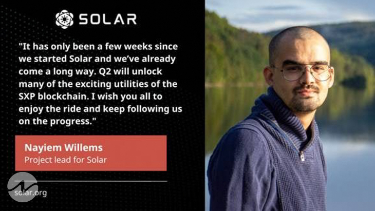Solar is a blockchain project led by a decentralized community that is currently working to build an ecosystem with decentralized governance.
On its mainnet launch on March 28th at 18:00 UTC, SXP, known as a token on Ethereum and Binance Smart Chain, is finally going to embark on its own layer-1 blockchain which is Solar, having SXP itself as the native coin.
This ecosystem will be focussing on open-source developers and community participation as Solar believes that the community plays a vital role. Moreover, Solar provides a wide range of capabilities and tools, allowing it to compete with enterprise-grade apps.
Everyone is encouraged to learn about the project’s ecosystem and participate in the community, as well as take part in its governance structure or perhaps even make a contribution to the platform.
Tell us a little about yourself
My name is Nayiem Willems, and I am the project lead for Solar. I am driven by the passion to do my part and help change the world for the better by utilizing the vast potential of blockchain technologies. You can follow me on Twitter, although all my tweets are my own personal views and should not be taken as concrete financial advice.
Tell us a little bit about your team
Solar is mostly made up of open-source developers from several top-tier initiatives, with myself serving as the project lead. Presently, the Solar team has 25 developers working on the project’s initial launch.
Also, Solar intends to introduce additional developers and contributors to the project using the DPoS (delegated proof of stake) consensus and compensates them with forging rewards provided for each block forged by delegates. Lastly, Solar will also have a ‘Community Fund’ to support specific initiatives that use the SXP network.
What prevailing blockchain issues can Solar solve that competitors can’t?
Unlike many traditional blockchains, Solar employs the Solar Core-powered Delegated Proof of Stake (DPoS) consensus model.
As a result, the Solar blockchain is sustainable, energy-efficient, and fully decentralized, with none of the recognized drawbacks associated with standard Proof of Work (PoW) blockchains, such as high energy consumption or 51% attack vectors.
There are 53 delegates, also known as node operators, on the Solar Blockchain. These delegates are chosen by the voters depending on the size of their SXP balance. 1 SXP equals 1 vote. The simplest approach to vote for a delegate is to download the Solar wallet and vote for one of your preferred delegates.
A delegate’s primary function is to contribute to the blockchain network by offering security advancements, code updates, marketing or brand development, and a variety of other activities. Delegates are rewarded for blocks created on the blockchain network, which they normally split with their voters.
These attributes ensure that Solar will be able to give a suitable solution to a wide range of challenges and services, and this versatility helps distinguish it from various other blockchains.
How can Solar reinforce the utility of SXP?
The idea to bring SXP to a native chain was planned ever since 2020. Now, thanks to the help of numerous community contributors and experienced developers, SXP aims to compete with leading platforms and projects in the blockchain industry such as EOS, Solana and Ethereum. Where other platforms show certain weaknesses in their code and in terms of scalability, SXP is here to improve.
SXP allows users to safely interact with a fast blockchain that is fully decentralized and utilizes the Delegated Proof of Stake consensus with 53 professional delegates. The project is being run by Solar, a true DAO that brings the control back to its users.
Users are able to benefit from amazing features on the SXP blockchain such as staking, creating fungible and non-fungible tokens, protocol-based burning mechanisms and a lot more tools to create amazing utilities such as on-chain launchpads, governance modules and interact with our very own metaverse.
When it comes to this space, there are plenty of viable projects. What makes your project so unique and ahead of its competitors? In other words, why should anyone invest in your project?
While it has to be said that due to the nature of the crypto, blockchain and DeFi sector, which is to say that it can be extremely volatile and unpredictable and therefore caution should always be exercised, nevertheless I believe that Solar has plenty to offer in terms of both its community and this industry as a whole. The roadmap has many other features that I have not been able to fully talk about in detail here, so it’s certainly worth taking a look at. It is important to remember that the key word in all of this is ‘utility’, so that will take precedence. And, of course, there’s the whitepaper that can be checked as well.
Additionally, experienced community developers have already started working on Solar, numerous companies have confirmed their desire to create a token using SLP, and delegates have begun to list their upcoming contributions too, all of which gives me confidence in the project’s readiness for its upcoming mainnet launch. We also have plans for NFT integration and the UI will be prioritized in order to provide a seamless experience with little to no problems. 90% of all fees will be automatically burned.
Furthermore, Solar has partnered with a small startup exchange that will list all projects created on SXP and will also be listed on a major exchange in Q2 that will target U.S traders. What’s more is that thanks to Solar, it is even possible to create ERC20 as well as ERC721 compatible tokens.

